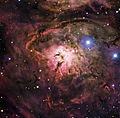Fail:Lagoon Nebula.jpg

Saiz pralihat ini: 610 × 599 piksel. Leraian-leraian lain: 244 × 240 piksel | 489 × 480 piksel | 782 × 768 piksel | 1,043 × 1,024 piksel | 1,841 × 1,808 piksel.
Fail asli (1,841 × 1,808 piksel, saiz fail: 2.92 MB, jenis MIME: image/jpeg)
Sejarah fail
Klik pada tarikh/waktu untuk melihat rupa fail tersebut pada waktu itu.
| Tarikh/Waktu | Gambar kenit | Ukuran | Pengguna | Komen | |
|---|---|---|---|---|---|
| semasa | 00:20, 4 Mac 2014 |  | 1,841 × 1,808 (2.92 MB) | Lmbuga | Putting the nebula in the center of the image |
| 07:48, 9 Ogos 2012 |  | 2,027 × 2,064 (1.59 MB) | Fabian RRRR | higher resolution | |
| 07:32, 22 April 2010 |  | 1,280 × 1,303 (317 KB) | EricHS211 | {{Information |Description={{en|1=Infrared view of the Cat’s Paw Nebula (NGC 6334) taken by VISTA. NGC 6334 is a vast region of star formation about 5500 light-years from Earth in the constellation of Scorpius. The whole gas cloud is about 50 light-year |
Penggunaan fail
Tiada laman yang menggunakan fail ini.
Penggunaan fail sejagat
Fail ini digunakan oleh wiki-wiki lain yang berikut:
- Penggunaan di ady.wikipedia.org
- Penggunaan di alt.wikipedia.org
- Penggunaan di av.wikipedia.org
- Penggunaan di bn.wikipedia.org
- Penggunaan di cs.wikipedia.org
- Penggunaan di cv.wikipedia.org
- Penggunaan di de.wikipedia.org
- Penggunaan di en.wikipedia.org
- Penggunaan di et.wikipedia.org
- Penggunaan di fr.wikipedia.org
- Penggunaan di hu.wikipedia.org
- Penggunaan di kaa.wikipedia.org
- Penggunaan di kk.wikipedia.org
- Penggunaan di koi.wikipedia.org
- Penggunaan di ko.wikipedia.org
- Penggunaan di kv.wikipedia.org
- Penggunaan di lez.wikipedia.org
- Penggunaan di mdf.wikipedia.org
- Penggunaan di mg.wikipedia.org
- Penggunaan di mk.wikipedia.org
- Penggunaan di mrj.wikipedia.org
- Penggunaan di olo.wikipedia.org
- Penggunaan di os.wikipedia.org
- Penggunaan di pl.wikipedia.org
- Penggunaan di pt.wikipedia.org
- Penggunaan di ru.wikipedia.org
- Penggunaan di sah.wikipedia.org
- Penggunaan di sh.wikipedia.org
- Penggunaan di sk.wikipedia.org
- Penggunaan di sv.wikipedia.org
- Penggunaan di tt.wikipedia.org
Lihat banyak lagi penggunaan sejagat bagi fail ini.


